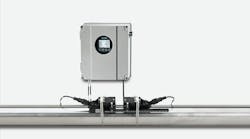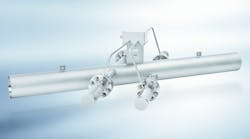Principle of Operation: There are two main types of ultrasonic flowmeters – transit-time and Doppler. Transit-time ultrasonic meters have both a sender and a receiver. They send an ultrasonic signal across a pipe at an angle and measure the time it takes for the signal to travel from one side of the pipe to the other. When the ultrasonic signal travels with the flow, it travels faster than when it travels against the flow. The ultrasonic flowmeter determines how long it takes for the signal to cross the pipe in one direction, and then determines how long it takes the signal to cross the pipe in the reverse direction. The difference between these times is proportional to flowrate. Transit-time ultrasonic flowmeters are mainly used for clean liquids. Doppler ultrasonic flowmeters also send an ultrasonic signal across a pipe. However, instead of sending it to a receiver on the other side of the pipe, the signal is reflected off of particles traveling in the flowstream. These particles are traveling at the same speed as the flow. As the signal passes through the stream, its frequency shifts in proportion to the mean velocity of the fluid. A receiver detects the reflected signal and measures its frequency. The meter calculates flow by comparing the generated and detected frequencies. Doppler ultrasonic flowmeters are used with dirty liquids or slurries. Multi-path transit-time ultrasonic flowmeters use multiple pairs of sending and receiving transducers to determine flowrate. The transducers alternate in their function as sender and receiver over the same path length. Flowrate is determined by averaging the values given by the different transducer pairs. This provides greater accuracy than single-path meters. Technology & Market Trends: Many technological improvements have been made in the ultrasonic flowmeter segment over the past 10 years. Due to improvements in electronic processing technology, transit-time meters are better able to handle fluids that are not completely clean. This has enabled transit-time flowmeters to be used for applications that could previously only be handled by Doppler flowmeters. These improvements have also increased the accuracy of ultrasonic meters, which has led to broader use of these meters in a wider variety of conditions. Multipath flowmeters have been especially important in the use of transit-time meters to measure natural gas flow. Suppliers such as Emerson Daniel (www.daniel.com), Elster-Instromet (www.americanmeter.com), and FMC Technologies (www.fmctechnologies.com) have introduced four-path, five-path, and six-path transit-time meters, respectively, to measure natural gas flow. In June 1998, the American Gas Association (www.aga.org) approved the use of multi-path ultrasonic flowmeters for custody transfer natural gas applications. Since that time, there has been a substantial increase in the use of these meters for natural gas measurement, especially for custody transfer applications. Another company that is offering multi-path ultrasonic flowmeters for custody transfer of natural gas is Sick AG (www.sick.com) of Germany. KROHNE (www.krohne.com) is also competing in this market with its ALTOSONIC V12, introduced in early 2009. Natural gas is not the only area where multi-path ultrasonic meters are being used. In 1997, KROHNE introduced a five-path transit-time meter for liquid applications. Just as in the multi-path meters for measuring the flow of natural gas, the five-path meter provides greater accuracy than single path meters. This meter is being used for custody transfer of liquids. In 2003, KROHNE followed up with its ALTOSONIC III. The American Petroleum Institute (API, www.api.org) has approved a draft standard for the use of ultrasonic flowmeters for custody transfer of liquids. News & Notes: One important recent development in the ultrasonic flowmeter space was the acquisition of Caldon by Cameron Measurement Systems (www.c-a-m.com) in May 2006. More recently, IDEX Corp. (www.idexcorp.com) purchased ADS LLC (www.adsenv.com) in January 2008, including its ultrasonic division. The Accusonic line includes multi-path ultrasonic flowmeters for hydroelectric penstocks, and large pipe and channel systems for cooling water and condenser water lines. In September 2008, Blue-White Industries (www.bluwhite.com) began shipping its new clamp-on Sonic-Pro ultrasonic flowmeters. The Sonic-Pro is a hybrid flowmeter that is selectable between transit-time and Doppler technologies. Jesse Yoder, Ph.D., is president of Flow Research, Inc. in Wakefield, Mass., a company he founded in 1998. For more on Flow Research’s coverage of ultrasonic flowmeters, visit www.flowultrasonic.com.


